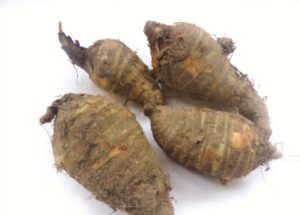This vegetable is extremely popular in the country and is used by all races in their kitchen. Some people don’t know how to cook Amadumbe and it’s not uncommon. This starchy veg can be difficult at times because it doesn’t always cook soft.
If you’re new to cooking with Amadumbe, this post will give you all the tips and tricks you need to prepare this nutritious vegetable in a variety of ways.
What is Amadumbe?
Amadumbe is a root vegetable that is native to Africa and Asia. It is closely related to other starchy vegetables like yams and potatoes. The plant has large leaves and can grow up to six feet tall. The roots are usually brown or black on the outside and white or cream-colored on the inside.
Amadumbe is an excellent source of carbohydrates and fibre, making it a great addition to any meal. It is also rich in vitamins and minerals like vitamin C, potassium, and magnesium. This vegetable is particularly popular in South Africa, where it is often used to make a dish called umngqusho, which is made with beans and served with meat.

How to Cook Amadumbe: Preparation
Before you can learn how to cook Amadumbe, you need to prepare it properly. The first step is to wash the roots thoroughly to remove any dirt or debris. Then, using a sharp knife, carefully peel away the skin. Be sure to remove any spots or blemishes on the surface of the root.
Once the Amadumbe has been peeled, it can be cut into slices or cubes, depending on how you plan to use it in your recipe. The vegetable can be boiled, roasted, or fried, depending on your preference.
Different Variations on How to Cook Amadumbe
You can learn how to cook Amadumbe in different ways such as:
Boiling Amadumbe
Boiling is one of the easiest ways to cook Amadumbe. To do this, simply place the sliced or cubed vegetable in a pot of boiling water and let it cook for 20-25 minutes or until it is tender. You can add salt or other seasonings to the water to enhance the flavour.
Once it is cooked, it can be mashed or pureed to create a creamy texture. This can be used as a base for soups or stews or served as a side dish.

See also: How to make Ujeqe
Roasting Amadumbe
Roasting is another great way to cook Amadumbe. To roast the vegetable, preheat your oven to 400°F. Cut it into slices or cubes and toss them with olive oil, salt, and pepper. Spread the pieces out on a baking sheet and roast them in the oven for 25-30 minutes or until they are tender and golden brown.
It can be served as a side dish or used as a topping for salads or sandwiches.
Frying Amadumbe
If you prefer a crispy texture, you can fry Amadumbe instead of boiling or roasting it. To do this, heat some oil in a frying pan over medium-high heat. Add the sliced or cubed Amadumbe to the pan and fry it for 5-7 minutes or until it is crispy and golden brown.
It can be served as a snack or used as a topping for tacos or burgers.
The Benefits of Eating Amadumbe
- Rich in Dietary Fiber: Amadumbe is an excellent source of dietary fiber, which plays a crucial role in maintaining a healthy digestive system. Adequate fiber intake promotes regular bowel movements, prevents constipation, and supports the growth of beneficial gut bacteria. By incorporating amadumbe into your diet, you can enhance your fiber intake and promote optimal digestive health.
- Provides Essential Vitamins and Minerals: Amadumbe is a treasure trove of essential vitamins and minerals. It is particularly rich in vitamin C, which supports immune function, collagen production, and aids in iron absorption. Additionally, amadumbe contains significant amounts of potassium, magnesium, and vitamin B6, all of which are important for various bodily functions, including heart health, nerve function, and energy metabolism.
- Supports Heart Health: The nutritional composition of amadumbe makes it beneficial for cardiovascular health. The tuber is low in saturated fat and cholesterol, making it a heart-friendly food choice. Moreover, the potassium content in amadumbe helps regulate blood pressure, reducing the risk of hypertension and related cardiovascular problems.
- Provides Antioxidant Protection: Amadumbe contains antioxidants that help protect the body against oxidative stress. These antioxidants, such as vitamin C and various phenolic compounds, neutralize harmful free radicals and reduce the risk of chronic diseases, including certain cancers and cardiovascular ailments. Including amadumbe in your diet can boost your antioxidant intake and contribute to overall well-being.
- Supports Weight Management: Due to its high fiber content and low-calorie nature, amadumbe can be a valuable addition to a weight management plan. The fiber in amadumbe promotes satiety, keeping you feeling full for longer periods, and reducing the likelihood of overeating. Additionally, the low-calorie content of amadumbe allows for guilt-free enjoyment, making it an excellent option for those looking to maintain a healthy weight.
- Promotes Bone Health: Amadumbe is a good source of calcium, an essential mineral for maintaining strong and healthy bones. Adequate calcium intake is crucial in preventing osteoporosis and reducing the risk of fractures. By including amadumbe in your diet, you can contribute to the maintenance of healthy bones and support overall skeletal health.
Conclusion
It is a delicious and nutritious vegetable that is easy to cook with once you know how to Amadumbe. Whether you prefer to boil, roast, or fry your Amadumbe, there are plenty of recipes to try. With its nutty flavour and creamy texture, this versatile vegetable is sure to become a staple in your kitchen.

